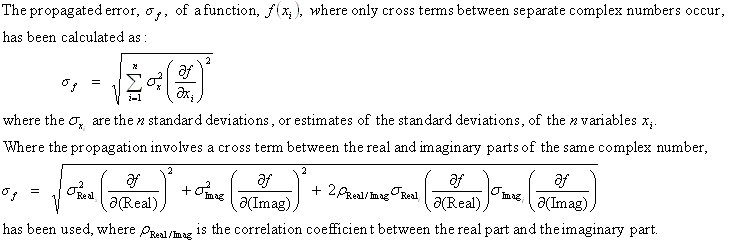|
Constructors |
public ComplexErrorProp()
|
|
public ComplexErrorProp(ErrorProp real, ErrorProp imag)
|
|
public ComplexErrorProp(ErrorProp real, ErrorProp imag, double corrCoeff)
|
|
public ComplexErrorProp(double realValue, double realError, double imagValue, double imagError)
|
|
public ComplexErrorProp(double realValue, double realError, double imagValue, double imagError, double corrCoeff)
|
|
|
Set Values |
public void reset(ErrorProp real, ErrorProp imag)
|
|
public void reset(ErrorProp real, ErrorProp imag, double corrCoeff)
|
|
public void reset(double realValue, double realError, double imagValue, double imagError)
|
|
public void reset(double realValue, double realError, double imagValue, double imagError, double corrCoeff)
|
|
public void polar(ErrorProp magn, ErrorProp phase)
|
|
public void polar(ErrorProp magn, ErrorProp phase, double corrCoeff)
|
|
public void polar(double magnValue, double magnError, double phaseValue, double phaseError)
|
|
public void polar(double magnValue, double magnError, double phaseValue, double phaseError, double corrCoeff)
|
|
public void setReal(ErrorProp real)
|
|
public void setReal(double realValue, double realError)
|
|
public void setImag(ErrorProp imag)
|
|
public void setImag(double imagValue, double imagError)
|
|
public void setDouble(double constant)
|
|
public void setCorrCoeff(double corrCoeff)
|
|
|
Get Values |
public ErrorProp getReal()
|
|
public double getRealValue()
|
|
public double getRealError()
|
|
public ErrorProp getImag()
|
|
public double getImagValue()
|
|
public double getImagError()
|
|
public double getCorrCoeff()
|
|
|
Copy |
public ComplexErrorProp copy()
|
public static ComplexErrorProp copy(ComplexErrorProp x)
|
public Object clone()
|
|
|
Truncate mantissae to n places
|
public ComplexErrorProp truncate(int n)
|
public static ComplexErrorProp truncate(ComplexErrorProp x, int n)
|
|
Print |
public void print(String message)
|
|
public void print()
|
|
public void println(String message)
|
|
public void println()
|
|
|
Conversions |
public String toString()
|
public static String toString(ComplexErrorProp aa)
|
|
Addition |
public ComplexErrorProp plus(ComplexErrorProp a)
|
public static ComplexErrorProp plus(ComplexErrorProp a, ComplexErrorProp b)
|
|
Subtraction |
public ComplexErrorProp minus(ComplexErrorProp a)
|
public static ComplexErrorProp minus(ComplexErrorProp a, ComplexErrorProp b)
|
|
Multiplication |
public ComplexErrorProp times(ComplexErrorProp a)
|
public static ComplexErrorProp times(ComplexErrorProp a, ComplexErrorProp b)
|
|
Division
|
public ComplexErrorProp over(ComplexErrorProp a)
|
public static ComplexErrorProp over(ComplexErrorProp a, ComplexErrorProp b)
|
|
Modulus (absolute value) |
public ErrorProp abs()
|
public static ErrorProp abs(ComplexErrorProp aa) |
|
Argument |
public ErrorProp arg()
|
public static ErrorProp arg(ComplexErrorProp aa) |
|
Exponential |
public ComplexErrorProp exp()
|
public static ComplexErrorProp exp(ComplexErrorProp aa) |
Some Useful
Numbers |
|
public static ComplexErrorProp zero()
|
|
|
public static ComplexErrorProp plusOne()
|
|
|
public static ComplexErrorProp minusOne()
|
|
|
public static ComplexErrorProp plusJay()
|
|
|
public static ComplexErrorProp minusJay()
|
|
Monte Carlo Simulation |
|
public static void setMonteCarloLength(int length)
|
|
|
public static int getMonteCarloLength()
|
